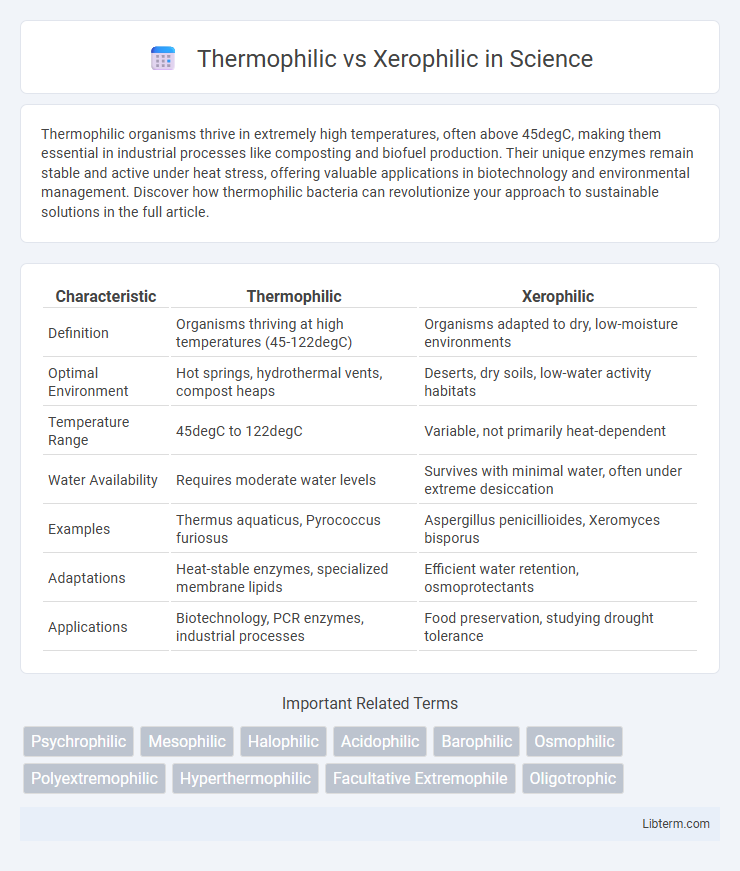Thermophilic organisms thrive in extremely high temperatures, often above 45degC, making them essential in industrial processes like composting and biofuel production. Their unique enzymes remain stable and active under heat stress, offering valuable applications in biotechnology and environmental management. Discover how thermophilic bacteria can revolutionize your approach to sustainable solutions in the full article.
Table of Comparison
| Characteristic | Thermophilic | Xerophilic |
|---|---|---|
| Definition | Organisms thriving at high temperatures (45-122degC) | Organisms adapted to dry, low-moisture environments |
| Optimal Environment | Hot springs, hydrothermal vents, compost heaps | Deserts, dry soils, low-water activity habitats |
| Temperature Range | 45degC to 122degC | Variable, not primarily heat-dependent |
| Water Availability | Requires moderate water levels | Survives with minimal water, often under extreme desiccation |
| Examples | Thermus aquaticus, Pyrococcus furiosus | Aspergillus penicillioides, Xeromyces bisporus |
| Adaptations | Heat-stable enzymes, specialized membrane lipids | Efficient water retention, osmoprotectants |
| Applications | Biotechnology, PCR enzymes, industrial processes | Food preservation, studying drought tolerance |
Introduction to Thermophilic and Xerophilic Organisms
Thermophilic organisms thrive in high-temperature environments, often between 45degC and 80degC, with adaptations in their proteins and membranes to maintain functionality under heat stress. Xerophilic organisms are specialized to survive in extremely dry conditions, exhibiting mechanisms such as cellular dehydration resistance and efficient water retention systems. Both types of extremophiles play crucial roles in biotechnological applications and ecological nutrient cycles by exploiting niches unsuitable for most life forms.
Defining Thermophiles: Heat-Loving Microbes
Thermophiles are heat-loving microbes that thrive at temperatures between 45degC and 80degC, often found in hot springs, compost heaps, and hydrothermal vents. These organisms possess specialized enzymes, such as thermostable DNA polymerases, enabling cellular processes to remain stable and efficient under extreme heat. Their adaptation to high temperatures distinguishes them from xerophiles, which specialize in surviving dry, low-moisture environments.
Understanding Xerophiles: Masters of Dry Environments
Xerophiles thrive in extremely dry environments by adapting to low water availability, enabling survival where most organisms cannot sustain life. Their cellular structures prevent water loss and maintain metabolic functions despite desiccation stress, distinguishing them from thermophiles, which specialize in high-temperature habitats. Understanding xerophiles' unique adaptations contributes to advances in biotechnology and agriculture by offering insights into drought resistance and preservation techniques.
Optimal Growth Conditions: Temperature vs. Moisture
Thermophilic organisms thrive at high temperatures, typically between 45degC and 80degC, optimizing their enzymatic activities and cellular processes for heat endurance. Xerophilic organisms are adapted to grow in environments with extremely low moisture availability, often below 0.75 water activity (aw), enabling survival in dry or desiccated conditions. The key distinction lies in thermophiles maximizing growth under elevated thermal conditions, while xerophiles excel in minimal water content, reflecting their specialized adaptations to temperature and moisture stress.
Adaptation Mechanisms: Thermophiles vs. Xerophiles
Thermophiles thrive in high-temperature environments by producing heat-stable enzymes and maintaining protein structures through specialized chaperones that prevent denaturation. Xerophiles adapt to extremely dry conditions by accumulating compatible solutes such as trehalose and synthesizing stress proteins to protect cellular components from dehydration. Both organisms exhibit unique membrane lipid compositions that enhance stability under thermal stress or water scarcity, enabling survival in their respective extreme habitats.
Ecological Niches and Natural Habitats
Thermophilic organisms thrive in ecological niches with high temperatures, such as hot springs, geothermal soils, and deep-sea hydrothermal vents, where they play crucial roles in nutrient cycling and organic matter decomposition. Xerophilic species are adapted to extreme dryness and are commonly found in arid deserts, salt flats, and drought-prone environments, contributing to soil stabilization and nutrient turnover under water-limited conditions. Both types exhibit specialized metabolic pathways and cellular adaptations that allow survival and ecological functioning in their distinct natural habitats.
Industrial and Biotechnological Applications
Thermophilic microorganisms, thriving at temperatures above 45degC, play a crucial role in industrial processes such as biofuel production, waste treatment, and enzyme manufacturing due to their heat-stable enzymes. Xerophilic organisms, which survive in low-water-activity environments, are essential in biotechnology for preserving food, producing dry enzyme powders, and stabilizing pharmaceuticals by withstanding desiccation. Exploiting thermophilic enzymes enhances reaction efficiency under harsh industrial conditions, while xerophilic adaptations enable product stability and extended shelf life in moisture-limited applications.
Comparative Survival Strategies
Thermophilic organisms thrive in extreme heat environments, utilizing heat-stable enzymes and specialized protein structures to maintain cellular functions at high temperatures. Xerophilic species survive in extremely dry conditions by employing mechanisms such as water retention, osmoprotectant synthesis, and reduced metabolic rates to prevent dehydration. Both exhibit unique biochemical adaptations that optimize their survival in conditions lethal to most life forms, highlighting divergent evolutionary strategies for coping with thermal and desiccation stress.
Challenges and Limitations in Research
Thermophilic microorganisms thrive at high temperatures, presenting challenges in maintaining stable laboratory conditions and specialized equipment for cultivation, while their enzymes can denature under slight temperature fluctuations. Xerophilic organisms, adapted to extremely low water availability, pose difficulties in replicating consistent desiccation environments and measuring metabolic activity due to their slow growth rates under arid conditions. Both thermophilic and xerophilic research faces limitations in genomic sequencing accuracy and functional annotation caused by their unique adaptations, complicating biotechnological applications and strain engineering.
Future Perspectives in Thermophilic and Xerophilic Studies
Future perspectives in thermophilic and xerophilic studies emphasize the exploration of extremozymes for industrial applications, including biofuel production and bioremediation under harsh conditions. Advances in genomic and metagenomic technologies are expected to enhance the discovery of novel thermophilic and xerophilic microorganisms with unique metabolic pathways. Integration of synthetic biology approaches will likely enable the engineering of robust microbial strains optimized for extreme heat and desiccation tolerance, expanding their utility in sustainable bioprocesses.
Thermophilic Infographic

 libterm.com
libterm.com